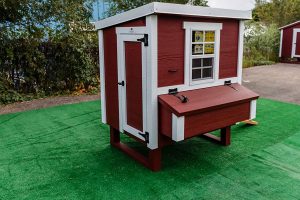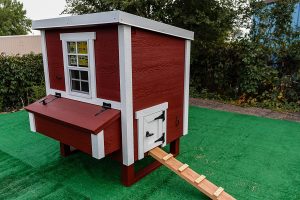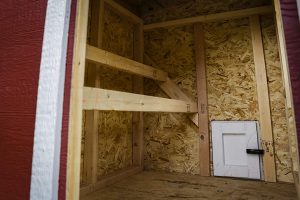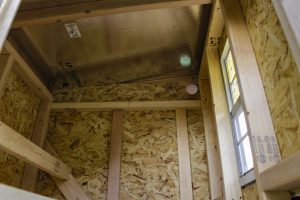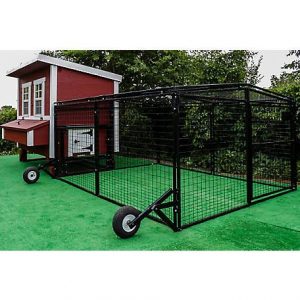The Amish have been renowned for exceptional craftsmanship for decades. So it wasn’t going to be long before they turned their hand to building some of the most robust designed chicken coops available to buy.
The thought and design of these coops are often second to none, making fine homes for chickens that lay really well in them. And that’s ultimately what you want from a coop, something that chickens will be really happy in and lay a huge number of awesome eggs.
The fact that Amish coops look fantastic is just another tick in the box. But add in that generally Amish built and designed coops will outlast most others coops – well that’s the icing on the cake.
Now most Amish chicken coops come with a heavy price tag, leaving them unaffordable for most people, but there are few that are completely within budget it’s just they can be hard to find!
So we’ve done hours of research to find, pick out and review the best Amish chicken coops using a method I call the sweet spot! The sweet spot is having all the best design and build features BUT getting them for the best price possible.
This has been honed over 4 generations on our farm, as we have had an endless amount of chicken coops in that time. We’ve had the good, the bad and the ugly. Things breaking on us in a matter of days, roofs leaking in a just a few months and coops just rotting to bits in under two years. All of which has meant we have learnt lessons about chicken coops but learnt them the hard way – through our pockets.
How much ‘coop space’ do chickens need?
A standard size chicken, I’m talking here breeds like Leghorns or Rhode Islands, will require a minimum of 3-4sqft per bird. Bantams require half that, again, as a minimum. Larger birds like Orpingtons, Australorps, Jersey Giants & Brahmas will require more space than standard size birds because, well, they are larger! Sometimes double or even triple the space.
How much ‘roost space’ do chickens require?
A roost is the bars in which chickens will sleep on during the night. Chickens require the dimensions shown below. [width is best described as the measurement from wing to wing]
- Bantams require 6-8 inches width per bird
- Standard size chickens 8-14 inches width per bird
- Larger chicken breeds 10-16 inches width per bird
We have now come up with a criteria for purchasing new chicken coops from all these expensive mistakes made in the past. Luckily Amish chicken coops tick all these boxes, which is why we like them so much, they are awesome but you knew that and that’s why you’re here.
I’ll share the main 4 point criteria for buying new chickens coops with you below:
-
Air Gaps for Ventilation
Air Temperature
Now this surprises most people who see this top of the list and please don’t just read on if you ‘live in a cold area’. Ventilation is required even if you keep chickens in the Alaska. It’s even more important in hot areas than cold yes, but let me explain why it’s so important.
A chicken coop that’s too hot will mean the birds will suffer from heat stress, too cold and they will suffer from getting sick and even frost bite.
Good, well positioned vents in a chicken coop helps to keep the coop at a goldilocks temperature [not too hot, not too cold]. Remember science class in high school: Heat travels hot to cold and moisture and pressure moves from high to low?
Most people think that ventilation works by cold air just coming in, too cool the coop. Yes that’s true but it not the full story. It’s actually the removal of the hot air in the first place that allows the cool air to replace it, so that cooling effect is infact the hot air leaving! This will happen, as heat travels hot to cold, i.e when it’s colder outside than inside the coop.
Moisture
But it’s not just air temperature that ventilation is vital for regulating, it’s also the removal of moisture. The moisture in the coop is usually the by-product of the chicken poop, and that just can’t be avoided, find me a chicken that cleans up after herself and ill place and order for 300!
Removal of that moisture is paramount for a healthy flock so that the coop doesn’t get ‘stuffy’ and so that moisture can’t condense, as it would then start getting everything inside wet.
Ammonia
Unfortunately another by-product from chicken poop is ammonia. Chickens are notorious for suffering with respiratory issues and ammonia can really exacerbate this. Good ventilation will ensure its removal from the coop so its levels don’t build up to be harmful to your chickens.
Ventilation Recap: Hugely important for the health and wellbeing of your flock, regardless of climate.
-
Safe from Predators
The role of the coop is for 3 main things; to keep the chickens safe, provide somewhere for them to roost at night and third thing is to have somewhere for them to lay eggs.
Keeping chickens safe from predators both ground and aerial is your job. They can’t protect themselves and 99% of this safety comes in the form of what coop [and run if needed] you buy. We have had predators get into our coop, we think a fox, and destroy everything inside. It’s heart breaking and even worse if you have children.
It’s therefore so important to have a really robust coop design and build quality. This is where Amish coops are just awesome, they are solid in all areas and often built like tanks.
Individually tiled roofs are a big no in my book. Anything that can be individually removed to gain access is totally counter intuitive. It won’t take a lot for a squirrel to get in through a hole where a tile was, then you have rain getting in and the inside is soaked and rotting from the inside out. You need a large roof made from ideally one single piece of material covered in a protective layer to waterproof it and to protect it from the sun.
The sides should well-constructed and meet ‘well’ at the corners, ideally with a something covering that join so that anything wishing to enter can’t use it to gain purchase.
Any windows or openings should be covered with a screen, there is no point having the rest of the coop being so secure to leave a window open. It puts a sign up to predators saying ‘well come on in!’.
Flooring – some people like them some don’t. I like them, floors mean nothing can dig under the coop and enter. Your protected from the bottom – its that simple.
-
Robust Design for Maximum Longevity!
Longevity and being predator proof go hand in hand. They are two sides of the same coin, as a well-built coop will be naturally predator proof by design.
Chickens have to have somewhere to live and purchasing a coop is the most expensive part of raising chickens, there is no way round it. So you need to make sure what you purchase is going to last BUT also give you best bang for your buck. Put another way, a $900 coop that lasts 10 years is better than a $2,000 coop that will last 12 years.
Starting from the top, you should be looking for a roof that over hangs the side walls, it only needs to be slightly. This is a benefit as it means that water will run off the roof straight onto the floor. Not down the sides of the walls too, potentially wetting the floor aswell.
The roof should also slope away from the nesting box meaning the run off from the water will go the same way as helping to keep nest boxes dry is really important.
The walls are floor should benefit from some kind of treatment. Now, to treat wood, or not to treat wood is a contentious issue within coops. Some treatments contains chemicals that are harmful to animals and as mentioned chickens are prone to respiratory issues already. The perfect middle ground is a resin. A resin will stand up to the moisture and provide good protection against all ’wear and tear’.
Top Tip : Don’t use a font style waterer inside the coop. Founts are messy and are always getting spilt by chickens. This could rot the floor. Try a nipple drinker inside the coop and keep the founts for outside.
-
Easy access
Coop
Cleaning is a mandatory chore that has to be done and that no one relishes. With that said, certain coop designs make life so much easier when it comes to cleaning. You ideally need access into the coop itself. Trying to do things from above or at an annoying angle on the side will drive you mad trying to get into every nook and cranny. We’ve had a coop where to clean it you nearly had to do a hand stand, all whilst holding a broom [you’ve probably been there] – never again.
Having access into the coop also means you can check up on birds in the coop too. As a sure fire way to tell if one of your chickens is having health problems is it alone in the coop, whilst the rest are outside enjoying themselves.
Nesting Boxes
I don’t know where this myth comes from, that each chicken will require its own nesting box. Probably made up by the marketing team of some coop manufacturers to differentiate themselves from others. Its complete nonsense. You actually require 1 nest for every 4-6 birds. And that’s laying hens too, don’t include cockerels in that, as they obviously don’t lay eggs. For some reason chickens will probably only use one or two of the nesting boxes, they seem to pick a favorite and just stick with it. Of our 20 chickens they will probably only use 2 of the nest boxes, max 3.
Having access to the nest boxes from the outside makes collecting your eggs every day an enjoyable task. Rather than having to crawl around on hands and knees trying to collect them and not break them climbing out of the coop. A latch and handle on the nest box lid is a real benefit too – trust me.
Chicken Pop Door [2 points]
- That’s the door the chicken will use to go in and out from the coop. This may sound obvious but it has to be easy enough for them to use, or the coop is useless. Can’t be too high up so they can’t get in or too low as it could mean it’s easy for vermin and water to get in!
- It’s the same conversation heard in every home ‘have you shut he chickens up for the night?’. Well a good coop now needs to accommodate for an automatic door, they are getting more and more popular as people see the benefits.
The Best Amish Chicken Coop
Ill cut to the chase, it’s the OverEz range of chickens coops. I could have written and reviewed 20 Amish coops but at 2-3k each they are out of price range of most people, including myself. I’m not going to review something I’ve never owned and couldn’t afford too. Plus most coops at double the price don’t stand up to the OverEz coops in so many ways.
OverEz tick all the boxes in the criteria mentioned above and go beyond that with some U.S.P’s of their own and I’ll cover those further down.
OverEz Small Chicken Coop Specs
- Dimensions: 34’’ L x 45’’ W [12.75 sqft of floor space] x 54 ½’’ H
- Windows: 1
- Vents: 2
- Nest Boxes: 2
*Perfect for: 3-4 standard chickens or 6-8 bantams or 2-3 larger breeds
OverEz Medium Chicken Coop Specs
- Dimensions: 50 1/4” L x52-1/2” W [18.32 sqft of floor space] x 62-1/4” H
- Windows: 1
- Vents: 2
- Nest boxes: 3
*Perfect for: 5-6 standard chickens or 10-12 bantams or 4-5 larger breeds
Over Ez Large Chicken Coop Specs
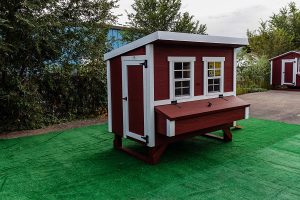
- Dimensions: 74” L x 60” W [30.8 sqft] x 72 1/2” H
- Windows: 2
- Vents: 2
- Nest Boxes: 5
*Perfect for: 8-11 standard chickens or 16-22 bantams or 7-8 larger breeds
*this is my calculation based on 3-4sqft per bird [which are guidelines from animal welfare charities.] Manufacturers often quite more than what I’ve quoted and this is misleading as they don’t specify the size of chicken. Use my calculations and you won’t go wrong.
OverEz Chicken Coop U.S.P’s
1 year warranty
That says it all, when manufacturers put a warranty on things it means they have trust in what they have made.
Vents [in the best places]
Remember my rant about vents above… well I didn’t mention positioning of those vents. Infront of the roost bars and your placing your hens in a draught and they will quickly catch cold. Not good at all. But at the top of the coop will mean, as hot air rises, that build-up of heat will be quickly and easily able to escape. Clever simple stuff. OverEz have nailed this having 2 vents at the top of the coop allowing air to flow through the coop and hot air to leave. Pat on the back for them.
Ample roost space
All the coop sizes have sufficient roost space for the chicken numbers quoted. Its important to remember during the winter they use less space, all huddling up to keep warm. In the summer though they need that extra space to spread out to keep cool.
The thing I really really like about the range from OverEz is that the roost bars are at two different heights. Did you know different chicken breeds roost at different heights? Most coops just have roost bars at the same height but having two different roost heights means you’ve covered your bases to house any breeds in you coop.
Radiant barrier on ceiling for cooling
This is implemented on no other coops, it’s a brilliant bit of thinking. Have radiant shield will reflect the heat trying to enter through the roof on really sunny days. This will also help to keep the coop cool if you have hot summers.
Resin treated floor and siding
Resin treating will add years to the lifespan of this coop
Metal roof [angled away from the nest boxes]
Roofs have to put up with rain, snow, sleet, wind, sun etc having a metal roof that will stand up to all these tests is brilliant.
30 mins DIY for construction
Coming fairly flat pack this coop requires just a screw gun to build and they have a video on YouTube to help too.
Sits off the ground
Keeps it out of any water or moisture forming on the ground. Allow air flow around the whole coop. Helps keep pout snakes, vermin and predators
Made in the USA
Nothing more to say on this point, buy well-built USA products and support your country.
Doors are lockable in both the open and closed position
This is great when sits windy, as something the chicken pop door can close shut during the day, really bad if their water or feed is inside. It’s a nice touch and adds to the extremely well built feel.
Great looking
Two color, traditional barn red and white, means it’s awesome looking and would look great in any backyard!
Chicken ramp included!
Extras [Runs, Wheels, Auto doors, Lights]
- Add on a custom run available in different sizes to suit your backyard requirements.
- Place wheels on the coops to turn them into a tractor and making moving the coop super easy!
- An automatic door, heating and lighting can be added and are sold in simple packages for easy fitting and usage.
For the best Amish crafted chicken coops look no further, OverEz have done an awesome job with their range, it’s easily the best designed coop and the build quality is superior to any other coop we have ever seen – so don’t waste your money on anything else.


